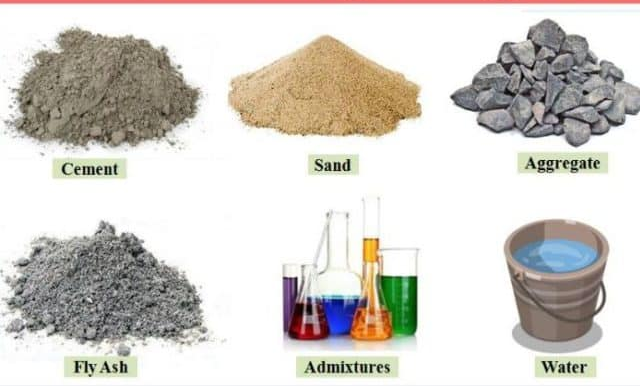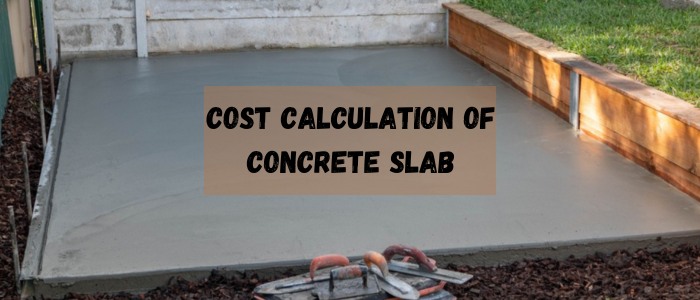What is concrete?
Concrete is a construction material that is widely used in the world. Concrete is made of the following components:
- Cement
- Water
- Fine aggregate (sand)
- Coarse aggregate (gravel or crushed stone)
- Admixtures
- Other components depending on use such as fibers

CONCRETE MIX DESIGN BY ACI [FULL GUIDE]
EXAMPLE OF ACI CONCRETE MIX DESIGN
Since concrete is not capable of resisting tensile forces, we use reinforcing steel bars for this purpose. Thus,
Reinforced concrete = concrete + reinforcing steel bars.
Cost Calculation of Concrete Slab
So when we say that we want to calculate the cost of a concrete slab, it means that we need to calculate the amount each component in concrete and see how much it costs.
Then, summing up the costs of all components, we get the total cost of concrete.
Is concrete cost constant in all countries?
Of course not.
Although we can have the same quantities of components, the cost of each component such as cement will differ from location to location. Thus, the cost will not be constant.
Required data for cost calculation
Before we start calculating the cost of concrete element such as slab, we need to know basic data such as:
Let us do our calculations on a 100 m2 (10m * 10 m) concrete slab that is made with M20 concrete mix and has a thickness of 200 mm.
In M20, M denotes Mix and 20 refers to the characteristic strength (fck) of that mix i.e. 20 MPa. Cement, sand and aggregates are used for mixing in the ratio of 1 : 1.5 : 3.
M20 signifies mixture of cement, sand and aggregate which are prepared in such a manner that a cement concrete cube of size 15 cm x 15 cm x 15 cm is formed with characteristic strength (fck) of 20 MPa while examining it after being cured for 28 days.
Steel needed for 100 sq m slab
Let us assume that structural design calculations for slab provided two layers of steel bars.
Each layer has main bars and cross bars:
Main bars exist in the shorter span and cross bars are perpendicular to main bars in the longer span.
Let us assume, for simplicity, that for bottom layer the main and cross bars are 5T16 / m and for top layer, the main and cross bars are 5T12 / m.
Summary of data:
Slab dimension = 10 m* 10 m
Thickness = 200 mm
Mix = M20 –> 1:1.5:3
RFT = 5T16/m for bottom layer and 5T12/m for top layer.
Steps for Cost Calculation of Concrete Slab
STEP 1: Volume Calculation ( wet & dry volumes)
Wet volume = Area × thickness of slab
Wet volume = 100 * 0.2 = 20 m3
Dry volume calculation
We need extra material because moist volumes include gaps and pores that are filled with water and bubbles and may be removed using a vibratory or compressor equipment.
We may multiply 1.54 by wet volume to determine dry volume since the mixture of cement, sand, and aggregates in dry concrete has more spaces and pores that evaporate in wet concrete. This causes the volume of wet concrete to drop by 54% while the amount of dry concrete increases by 54%.
Dry volume = 1.54 * 20 = 30.8 m3
Amount of Required Cement
In M20 ratio of cement, sand and aggregate is 1:1.5:3
Total proportion =1 + 1.5 + 3 = 5.5
Weight of cement = 1 / 5.5 * dry volume * density of cement
Weight of cement = 1 / 5.5 * 30.8 * 1450 = 8120 kg
Weight of cement bag = 50 kg
No. of required cement bags = 8120 / 50 = 163 bags.
Amount of Required Sand
Volume of sand = 1.5 / 5.5 * dry volume
Volume of sand = 1.5 / 5.5 * 30.8 = 8.4 m3
Amount of Required Aggregate
Volume of aggregate = 3 / 5.5 * dry volume
Volume of aggregate = 3 / 5.5 * 30.8 = 16.8 m3
Amount of Required Steel
Volume of steel bars = Number of bars * Area of bar * length of bar
Number of bars in 10 m length = 10 * 5 (number of bars in one meter) = 50 bars
Length of bars = 10 m
Area of bar = 0.25 * 3.14 * (bar diameter)2
For bar 16 mm, Area = 2.01*10-4
For bar 12 mm, Area = 1.13*10-4
Volume of steel bars in bottom layer = 2 (main and cross bars) * 50 * 2.01*10-4 * 10 = 0.201 m3
Volume of steel bars in Top layer = 2 (main and cross bars) * 50 * 1.13*10-4 * 10 = 0.113 m3
Weight of steel = density * volume = 7.85 (ton/m3) * (0.201 + 0.113) = 2.5 ton
Summary of materials:
- Cement = 163 bags
- Sand = 8.4 m3
- Aggregate = 16.8 m3
- Steel = 2.5 tons
Now, depending on where you are, you can multiply each amount by its price and get the cost of materials required for concrete.
After that, you can calculate the cost of workmanship
Total cost = cost of materials + cost of workmanship
Read Also:
